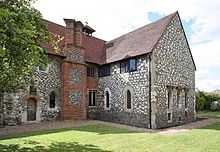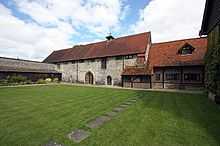Burnham Abbey


Burnham Abbey is a house of Anglican nuns near Burnham in Buckinghamshire, England.
It was originally founded as a house of Augustinian nuns by Richard, 1st Earl of Cornwall. The Medieval community consisted of around twenty nuns at the outset, but was never especially wealthy and by the time of the dissolution in 1539 there were only ten.
History
The Abbey was founded in 1265/6 by Richard, Earl of Cornwall, styled King of the Romans,[1] the brother of King Edward III. Richard endowed it with several manors, including the manor of Burnham, and 'land appurtenant to the manor of Cippenham with a mill, fishery and other rights'. [2] The Abbey was situated about a half mile from Burnham.[3] A complaint was made shortly after the foundation that Richard had diverted a watercourse to the abbey that had been used by a nearby village and that he also had given 20 acres (81,000 m2) of common land to the monastery. It is unknown as to whether this issue was resolved.
In 1311 a nun, Margery of Hedsor, left the monastery and her vows and was subsequently excommunicated. This sentence was renewed periodically for some years until it was cancelled by the Bishop for reasons unknown. A serious legal dispute occurred in 1330. This was concerning the ownership of the manor of Bulstrode, which had been granted to the abbey but was claimed by a Geoffrey de Bulstrode, who in protest proceeded to vandalise the property and harass the servants of the abbess. Eventually a commission found in favour of the abbey but by then, substantial losses had been accrued.
Being of little wealth, Burnham Abbey should have been closed in the first wave of the dissolution in 1536, but a petition by local commissioners delayed its end to 1539. The document of surrender, dated 19 September 1539, was signed by Alice Baldwin, as Abbess, and the nine remaining nuns. At the dissolution, the Abbey’s revenues were valued at £51 2s 4-1/2d.[3] Baldwin was granted a small pension[4] and appears to have spent her remaining years at Aylesbury at the home of her father, Sir John Baldwin.[5]
After the surrender it was leased to William Tyldesley and his death, it passed through his widow to Paul Wentworth. The church was demolished in about 1570 and a house formed from much of the remaining buildings. By 1719, it was a farm with some of the buildings such as the refectory having become ruinous. In 1913 it was purchased by James Lawrence Bissley, an architect and surveyor, who restored the remaining buildings and converted the original chapter house into a chapel.
In 1916 James Bissley sold the property to the Society of the Precious Blood, a community of Anglican Augustinian nuns, who took possession and began to restore and extend the abbey for their use.[6]
Buildings
The Abbey is a Grade I listed building[7] and the associated walls and structures are Grade II. The chapter house, sacristy, and parts of the frater and infirmary remain of the medieval convent.
References
- ↑ 'Parishes: Burnham with Lower Boveney', A History of the County of Buckingham: Volume 3 (1925), pp. 165-184 Retrieved 12 May 2013.
- ↑ 'House of Austin nuns: The abbey of Burnham', A History of the County of Buckingham: Volume 1 (1905), pp. 382-384 Retrieved 6 June 2013.
- ↑ 3.0 3.1 Sheahan 1862, p. 816.
- ↑ Gasquet 1889, p. 213.
- ↑ Lipscomb II 1847, p. 209.
- ↑ SPB website
- ↑ Historic England. "Burnham Abbey (Grade I) (1124475)". National Heritage List for England. Retrieved 8 January 2015.
- 'House of Austin nuns: The abbey of Burnham', A History of the County of Buckingham: Volume 1 (1905), pp. 382–84.
- Anthony New; A Guide to the Abbeys of England And Wales, p88-90. Constable.
External links
| Wikimedia Commons has media related to Burnham Abbey. |